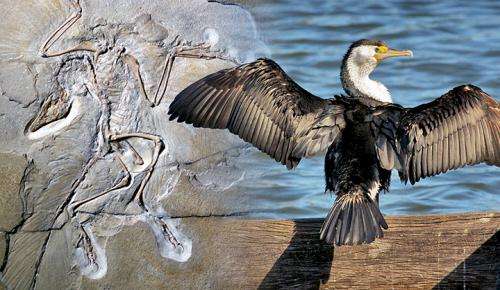Differences in feathers shed light on evolution of flight

The asymmetrical flight feathers of their wings are among the most distinctive features of living birds. But how are these feathers actually constructed, and when did they first appear in evolutionary history?
New Yale research, published Feb. 11 in Proceedings of the Royal Society B, found subtle differences between modern bird feathers and those of ancient feathered dinosaurs like Archaeopteryx, an ancestor of birds that took to the air 150 million years ago.
"Archaeopteryx has occupied a central place in the morphological transition from dinosaurs to modern birds, but researchers can't agree on whether it was fully capable of modern, powered flight," said Teresa Feo, lead author of the study and doctoral candidate in the lab of Richard Prum in the Department of Ecology and Evolutionary Biology.
Early feathered dinosaurs, such as Archaeopteryx, exhibit asymmetrical feathers that had always been thought to be indistinguishable from those of living birds.
"This is a well-appreciated adaptation that provides aerodynamic stability," said Feo. "It is clear that these animals were doing something in the air."
Feo and fellow doctoral candidate Daniel Field decided to take a closer look at feathers representing the evolutionary transition from dinosaurs to modern birds. They found that while the shape of the wing feathers of Archaeopteryx and modern birds are generally similar, their trailing edges differed significantly in the angle where feather branches connected to the central shaft. These structural changes might be important in enabling a coherent wing surface during sustained flight, they said.
"Our findings help us understand how these feathers facilitate flight in modern birds," said Field, a paleontologist, ornithologist, and doctoral candidate in Yale's Department of Geology & Geophysics. "Although the asymmetrical feathers of the Mesozoic fossils like Archaeopteryx and Microraptor indicate some capacity for aerial locomotion, there is growing evidence to suggest that this ability was considerably less sophisticated than that of living birds."
"In a way, it is more of a semantic debate," Feo said. "The Wright Brothers' plane flew, but not like a modern jet fighter. Flight is a complicated thing."
More information: Barb geometry of asymmetrical feathers reveals a transitional morphology in the evolution of avian flight, rspb.royalsocietypublishing.or … nt/282/1803/20142864
Journal information: Proceedings of the Royal Society B
Provided by Yale University




















